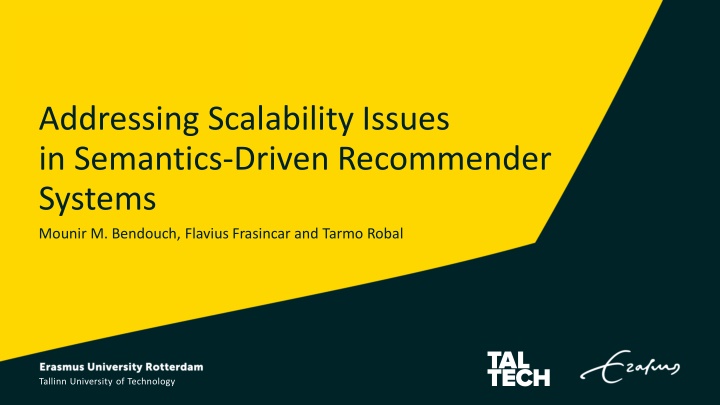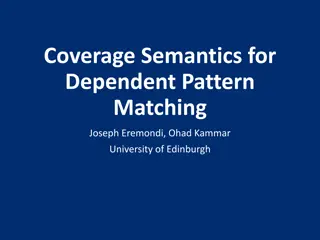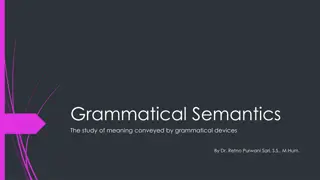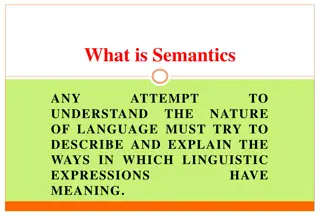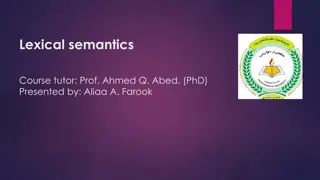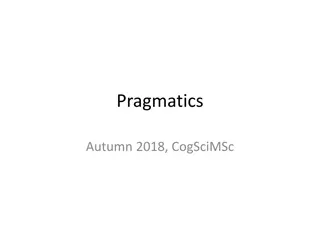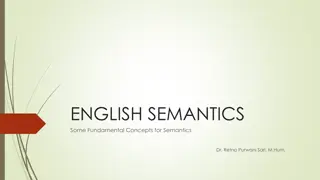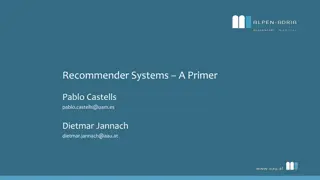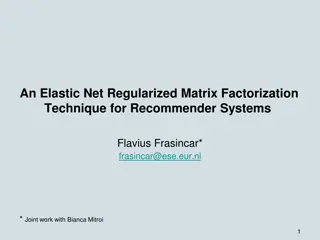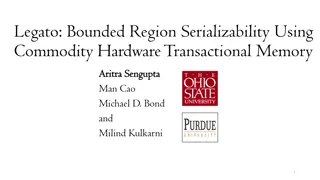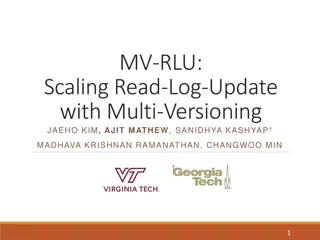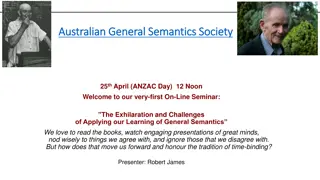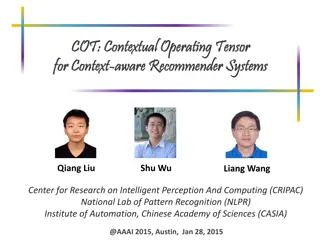Addressing Scalability Issues in Semantics-Driven Recommender Systems
This research delves into addressing scalability challenges in semantics-driven recommender systems, focusing on TF-IDF as a common measure and exploring various feature extraction and similarity models. The study highlights the importance of user preferences and behavior in automatically finding relevant content to combat information overload. Key topics covered include collaborative filtering, content-based recommendation, and the application of TF-IDF to translate user interests into vector weights.
Uploaded on Mar 07, 2025 | 1 Views
Download Presentation

Please find below an Image/Link to download the presentation.
The content on the website is provided AS IS for your information and personal use only. It may not be sold, licensed, or shared on other websites without obtaining consent from the author.If you encounter any issues during the download, it is possible that the publisher has removed the file from their server.
You are allowed to download the files provided on this website for personal or commercial use, subject to the condition that they are used lawfully. All files are the property of their respective owners.
The content on the website is provided AS IS for your information and personal use only. It may not be sold, licensed, or shared on other websites without obtaining consent from the author.
E N D
Presentation Transcript
School of Information Technologies Addressing Scalability Issues in Semantics-Driven Recommender Systems Mounir M. Bendouch, Flavius Frasincar and Tarmo Robal Tallinn University of Technology
Agenda Introduction & Background TF-IDF and Semantics-driven recommenders SF-IDF, SF-IDF+, CF-IDF, CF-IDF+, Bing-SF-IDF+, Up-scaling Feature extraction Domain ontology construction Similarity model Evaluation Conclusions The 20th IEEE/WIC/ACM International Conference on Web Intelligence and Intelligent Agent Technology (WI-IAT'21)
Introduction Information overload Need for automated and accurate approach in Web to distinguish relevant and non- relevant Recommender systems (RS) help users to plough through a massive and increasing amount of information Automatically find relevant content based on: user preferences, profiles, behaviour The 20th IEEE/WIC/ACM International Conference on Web Intelligence and Intelligent Agent Technology (WI-IAT'21)
Introduction Recommender systems (RS): Collaborative filtering Content-based Hybrid Content-based RS: Vary in features exploited and used for similarity calculations Are often term-based Common measure: Term (TF-IDF) as proposed by [Salton and Buckley, 1988] Users interests translated into vectors TF-IDF weights Weights computed for every term within a document Frequency Inverse Document Frequency The 20th IEEE/WIC/ACM International Conference on Web Intelligence and Intelligent Agent Technology (WI-IAT'21)
Introduction: TF-IDF TF-IDF: Pre-processed documents (stop words removal and stemming) For each term, it takes into consideration: The importance in a single document The inverse of the general importance within a set of documents IMPORTANT TERMS: red, purple, and blue Irrelevant terms: yellow, green, and pink The 20th IEEE/WIC/ACM International Conference on Web Intelligence and Intelligent Agent Technology (WI-IAT'21)
Introduction: Motivation Several RS build upon TF-IDF in the news recommendation domain Concept Frequency Inverse Document Frequency (CF-IDF) Concepts from domain ontologies (CF-IDF) Concepts and related concepts from domain ontologies (CF-IDF+) Synset Frequency Inverse Document Frequency (SF-IDF) Terms, Synonyms from semantic lexicon (SF-IDF) Synsets and their 27 semantic relationship types (SF-IDF+) Extended with similarity between named entities on the Web (Bing-SF-IDF+) Combined with domain concepts (Bing-CSF-IDF+) The 20th IEEE/WIC/ACM International Conference on Web Intelligence and Intelligent Agent Technology (WI-IAT'21)
Semantics-Driven Recommenders for News Recommendation SEMANTIC LEXICON extend extend SF-IDF SF-IDF+ Bing-SF-IDF+ build on Synsets Synsets + Relationships TF-IDF (27 weights) combines Terms Bing-CSF-IDF+ build on combines extend CF-IDF CF-IDF+ Concepts Concepts + Relationships (3 weights) DOMAIN ONTOLOGY The 20th IEEE/WIC/ACM International Conference on Web Intelligence and Intelligent Agent Technology (WI-IAT'21)
Introduction Good results obtained with SF/CF-IDF(+), Bing-(C)SF-IDF+ for News Article RS Features from article text Suitable for predicting similarity of any two texts How about large-scale recommendations? Can these methods be extended? The 20th IEEE/WIC/ACM International Conference on Web Intelligence and Intelligent Agent Technology (WI-IAT'21)
Research Questions RQ1: Whether and how can semantics-driven recommenders be applied to a large-scale recommendation problem? RQ2: How to scale the existing proven approach to large(r) datasets? Domain: Movies More complex Information of different nature, not only text The 20th IEEE/WIC/ACM International Conference on Web Intelligence and Intelligent Agent Technology (WI-IAT'21)
Research Data User ratings from MovieLens 20M dataset 20,000,000 user ratings (5-star) from 138,493 users 27,278 movies 10+ year period Item level information Title, year, genre labels, IMDB ID from MovieLens Plots, Persons, genres from OMDb Genres from both MovieLens and OMDb kept Movies without at least one director, actor, writer, genre and plot are disregarded Final dataset: 25,138 movies The 20th IEEE/WIC/ACM International Conference on Web Intelligence and Intelligent Agent Technology (WI-IAT'21)
Research Data Final dataset: 25,138 movies The 20th IEEE/WIC/ACM International Conference on Web Intelligence and Intelligent Agent Technology (WI-IAT'21)
Feature Extraction Some concepts readily available: Director, Writer, Actor, Genres Terms and synsets extracted from plots NLP + POS + Porter stemming Adapted Lesk for WSD to extract synsets The 20th IEEE/WIC/ACM International Conference on Web Intelligence and Intelligent Agent Technology (WI-IAT'21)
Feature Extraction Directors: Actors: Writers: Genres (ML): Genres (OMDb): John Lasseter Variables Tom Hanks, Tim Allen, Don Rickles, Andrew Stanton, Joe Ranft, DOMAIN ONTOLOGY Animation, Adventure, Family, Comedy Adventure, Computer Animation, Comedy Source: OMDb A little boy named Andy loves to be in his room, playingwith his toys, especially his doll named Woody. But, what do the toys do when Andy is not with them, they come to life. Semantic Lexicon TERMS Plot: 146 words Related SYNSETS SYNSETS Terms: boy, toys, doll, birthday, Synsets The 20th IEEE/WIC/ACM International Conference on Web Intelligence and Intelligent Agent Technology (WI-IAT'21)
Domain Ontology Usually external and need to be obtained or manually constructed for RS Alternative general method to external domain ontologies Solely based on dataset Through series of matrix multiplications of binary matrices 12,231 Directors 292,857 bi-directional movie-concept relations 45,393 Actors 25,138 Movies 27,415 Writers 19 Genres (ML) VIRTUAL ONTOLOGY 27 Genres (OMDb) CONCEPT CLASSES The 20th IEEE/WIC/ACM International Conference on Web Intelligence and Intelligent Agent Technology (WI-IAT'21)
Domain Ontology k concept classes => k binary matrices M = z n Sum(row) = no of concepts in item; 1 Sum(col) = no of items with a concept; 1 Related concepts identified through matrix multiplications of k matrices M through any path length k=5 (Directors, Actors, Writers, GenresML, GenresOMDb) Method as an alternative to external ontology The 20th IEEE/WIC/ACM International Conference on Web Intelligence and Intelligent Agent Technology (WI-IAT'21)
Similarity Model Traditional method IDF applied to terms and synsets from plots Exception for concepts no IDF scaling Not from text, frequencies {0, 1} One vector of features from user profile One vector of features from unseen item for consideration Evaluation: cosine similarity Increase CF-IDF+ parametric freedom: Concepts of each class in separate vectors The 20th IEEE/WIC/ACM International Conference on Web Intelligence and Intelligent Agent Technology (WI-IAT'21)
Similarity Model Existing similarity model rewriten as a function of dot-products of feature vectors of individual items Pre-computed before optimization Unseen item User profile Learnablebias sim as score [0, 1] Logloss over observed likes y {0,1} and predicted similarity sim [0,1] Similarity interpreted as probability of a like given in input data The 20th IEEE/WIC/ACM International Conference on Web Intelligence and Intelligent Agent Technology (WI-IAT'21)
Experimental Setup Similarity model trained on pairs of user-profiles and unseen items Trained model used to recommend items where sim > threshold Stochastic gradient descent (SGD) applied to optimize weights Item considered to be liked if user rates it with score 4.5 Avg proportion of liked items: 19.2% Avg number of liked items per user: 20.9 The 20th IEEE/WIC/ACM International Conference on Web Intelligence and Intelligent Agent Technology (WI-IAT'21)
Experimental Setup Users order shuffled in dataset 1000 as test dataset for evaluation 1000 as validation for the sim model for early stopping while training 136,493 as training set to optimize sim model User profiles constructed by sampling p=5 liked items from a user Unseen items defined as not in the user profile Liked/disliked items sampled with equal probability All discarded items considered to be seen simulating the situation where RS detects user has liked p=5 items Final set of user profiles: 809 The 20th IEEE/WIC/ACM International Conference on Web Intelligence and Intelligent Agent Technology (WI-IAT'21)
Experimental Setup Semantic-driven recommender models tested T: as TF-IDF used as benchmark S: as SF-IDF+ based on synsets from plots C: as modified CF-IDF+ using features directly captured from variables C+S: as combination of models C and S Optimization implemented in Python v.2.7 using Keras and Theano libraries Regular PC with NVIDIA GTX1060 GPU Parallel computations of gradients The 20th IEEE/WIC/ACM International Conference on Web Intelligence and Intelligent Agent Technology (WI-IAT'21)
Results 10 random restarts, each model initiated with random weights nvalitation=102,400; ntrain=1,406976 observations Lowered training time important practical outcome With the scalable approach (pre-computed dot-products) we can optimize the model in 4-5 minutes The 20th IEEE/WIC/ACM International Conference on Web Intelligence and Intelligent Agent Technology (WI-IAT'21)
Results Performance calculated for all 809 user profiles Not directly optimized towards the metrics Unexpectedly low performance for SF-IDF+ Concepts alone outperform the benchmark T ? ? AUC F1 Model ROC 0.535 0.531 0.567 0.570 PR min? ? 0.413 0.411 0.419 0.419 max? ? 0.479 0.477 0.507 0.509 min? ? 0.041 0.038 0.081 0.083 max? ? 0.200 0.198 0.249 0.251 T S C 0.324 0.319 0.358 0.361 C+S The 20th IEEE/WIC/ACM International Conference on Web Intelligence and Intelligent Agent Technology (WI-IAT'21)
Contributions Method for extracting semantic features from complex domain information for semantics-driven RS Method for devising domain ontology when no external ontology is readily available Method to scale up existing semantics-driven RS for large-scale variable data with pre-computation of cosine similarities and gradient learning of the model Semantics-driven RS can be scaled by rewriting the similarity model as a function of the dot-products of feature vectors of individual items Fast optimization of models The 20th IEEE/WIC/ACM International Conference on Web Intelligence and Intelligent Agent Technology (WI-IAT'21)
School of Information Technologies Thank you! Tallinn University of Technology The 20th IEEE/WIC/ACM International Conference on Web Intelligence and Intelligent Agent Technology (WI-IAT'21)
The 20th IEEE/WIC/ACM International Conference on Web Intelligence and Intelligent Agent Technology (WI-IAT'21)
